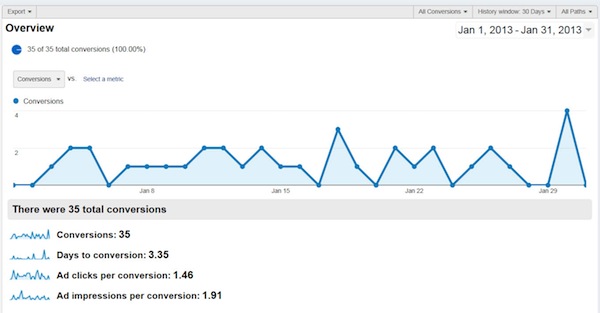PPC conversion tracking has evolved greatly over the past decade or so. In the early days, few advertisers were tracking conversions at all. Web analytics software was a new and expensive proposition, and most companies didn’t take advantage of it. They were just happy to get “hits” to their website. The few advertisers who were tracking conversions were likely using last-click attribution.
Over the past couple of years, web analytics and conversion tracking has morphed into an industry unto itself. Entire sessions at search conferences have been devoted to attribution modeling.
Sophisticated tracking tools now exist whereby advertisers can decide which channels should get the credit for a sale. In some companies, the process of attribution consumes significant time and resources.
But let’s back up for a minute. While fancy attribution modeling is a reality today, most companies aren’t using it. It’s expensive, and marketers don’t understand it. Multichannel attribution isn’t going away, though, so it’s time to understand how it works.
The simplest way to get started with multichannel attribution is with multichannel funnels in Google Analytics. Ideally, this is already set up for the websites you’re working with; if not, you can find set-up documentation here.
Multichannel funnels are a powerful tool for PPC. Many PPC advertisers are reluctant to spend heavily on awareness-type keywords, because these keywords don’t generate many first-click conversions. With multichannel funnels, you can see which campaigns and keywords eventually led to a conversion. The data can be striking.

In this instance, the second campaign in the list had 24 last interaction conversions, and 52 assisted conversions. In other words, there were twice as many assisted conversions as last interaction conversions!
Think about that for a minute. Remember, the only conversions that show up in most campaign report views are last interaction conversions. That means that in this case, the value of this campaign likely has been drastically understated.
Without looking at the multichannel funnel report, keywords and ads that are generating assisted conversions might get paused – ultimately lowering the total number of conversions for this advertiser.
Cross-channel integration can also be measured by multichannel funnels. PPC might not be the highest source of last interaction conversions, but it very well could be generating significant numbers of assists. And PPC might be reaching new customers at a high rate, who often require more than one visit to convert.
Here’s an example:

Paid search is highlighted in the image. In this case, paid search is generating more conversions from new visitors than from repeat visitors, and nearly twice as many assists came from new visitors as from returning visitors.
If you’re using Google AdWords conversion tracking, you’ll also find some useful data in the Search Funnels reports. To find the Search Funnels reports in AdWords, go to Tools, then choose Conversions, and then choose Search Funnels.
Search funnel reports will give you a good idea of how visitors are converting: how many days, impressions, and clicks it takes for someone to convert.

There are also some cool reports within Search Funnels that will lend insight into your conversion path. For example, you can view assist impressions, which shows you ads that had impressions but not clicks, that eventually led to a conversion.

For this client, most of the conversion took place on a last click basis, but there were several campaigns that had assisted impressions but not clicks. This could indicate that people are performing several non-branded searches to research the product, and finally convert on a brand search (a typical scenario).
It’s important not to over-weight branded campaigns and cut back on non-branded campaigns, because the non-branded campaigns often contribute via assisted impressions or clicks.
Another important report in the Search Funnels section is the Time Lag report. The time lag report shows how many days it takes for a visitor to convert. Not every conversion happens on the first visit, and the data can be insightful:

In this case, most of the conversions happen the same day. But 11 percent of conversions are happening 12 or more days down the road, and the average number of days to conversion is 3 days! It’s important to use this data to remind stakeholders that today’s ads may lead to tomorrow’s conversions.
To learn more, here is a good overview of uses for search funnels.
What does this all mean? Should we be weighting assisted conversions the same as last interaction conversions? Probably not.
When you’re paying for every click, obviously the clicks that generate immediate conversions are more valuable than clicks that didn’t convert but later resulted in a conversion somehow. But it’s important to understand how multiple touches across channels work together to generate conversions.
Have you used multichannel attribution for PPC? What have you learned from multichannel attribution?




